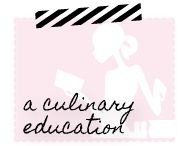Week 1: Let's go to Germany
This was a demonstration only class. As in the first class of Culinary Arts I, the expectations were set for the course, discussing any new tools that might be needed and uniform requirements. Demonstrated was Turkey Schnitzel, Sauce Gribiche (a tartar-like sauce to eat with the Turkey Schnitzel), Mayonnaise (which was used to make the Sauce Gribiche) a warm German potato salad and braised cabbage. I was pleasantly surprised by the content of this first class, as I love German/Austrian food (my favourite restaurant in the world is an Austrian restaurant - and at my favourite restaurant, breaded shrimp is my favourite thing to eat....go figure that Austria is landlocked....). The warm German potato salad had bacon (and pickles), so I was a fan. The cabbage had apples, bacon (bacon makes everything taste better - even cabbage) cloves, allspice, cinnamon, red wine vinegar and wine.
Week 2: Tourtière - Quebec Style
This was the week that I was introduced to the wonderful world of ' The Tourtière'. This is one of the things that I love the most about taking these courses. It opens me up to the world of possibilities in the culinary universe! Tourtière is delicious! It's Awe-(wait for it)-Some ( I love 'How I Met Your Mother'). It's a savoury, clove-y, cinnamon-y, nutmeg-y meat-y pie (yum). I'll include this recipe, which I've adapted to my own tastes (based on the one in the George Brown manual) in a subsequent post. Cheese scones were also included in the demo. I felt bad for the scones. They were totally overshadowed by the wonder that was the Tourtière.
Week 3: Flambé
I like to flambé things (this became extremely apparent because for the rest of the course I tried to light everything that had brandy or wine in it on fire). After taking this class, I now fully understand that flambé-ing doesn't actually change the way anything tastes and that it's really just for show, but it's fun (as long as you don't burn your eyebrows off). This week, Chicken Cordon Bleu and Chicken Breast Chasseur are demonstrated with the latter included in lab. Chicken Breast Chasseur is one of those things that I don't know if I would ever make again (I didn't love the sauce espagnole and tomato combination) - but because you get to light stuff on fire - I might. Green Bean Almondine is also demonstrated in this class. Turns out that green beans and almonds taste good together. Who knew?
Week 4: Salmon Coulibiac
So, I like horseradish, dill, mushrooms, salmon, egg, rice, onions and leeks. But when they are all put together in a pastry, this is something that I do not like. It was a flavourless assault on my senses (maybe I should have tried it with some hot sauce). I am sure there are a lot of people out there who like Coulibiac (from what I understand, this is a Russian favourite). I will never be one of those people.
The other dishes that were included in the demo for this week are good, so it sort of makes up for the above. These are Lobster Bisque, Sole Joinville and Creamed Horseradish (which is used in the aforementioned abomination - yup, I feel that strongly about it).
Week 5: Odd Recipe Names...
Breast of Chicken Archduke (I guess this is one of the best things about making up a recipe....you get to name it, regardless of its relevance to the ingredients) is demonstrated in this class, as well as Fettuccini Alla Pesto (which is basically Fettuccine Alfredo with Pesto). Breast of Chicken Niagara (as far as I could tell, this recipe had nothing to do with Niagara Falls, Niagara-On-The-Lake, or even the Niagara Region) was part of the lab. The ingredient list for this recipe included bacon, wine, rosemary and nutmeg...among other things. It's good to have a few different recipes to use for a refrigerator staple like 'the chicken breast' - and when your dinner guests ask what the recipe is called, it has the possibility of being interesting dinner conversation!
Week 6: Veal
I've never been a big fan of veal - mainly cause of the animal welfare issues. It's just one of those things.
And although I am glad I experienced it, I don't think that it's an ingredient which I will be using excessively. The instructor okay with the students who didn't want to have anything to do with the veal and provided them with chicken for the lab. Veal Marsala and Roesti's were part of the demo in this class. Paupiettes of Veal was included in the lab, which is basically veal stuffed with a gherkins and mustard in a tomato based sauce.
Week 7: Lamb
This week, Rack of Lamb Persille and Stuffed Tomato's were demonstrated. The lamb recipe was a good introduction of how to handle a rack of lamb and clean it for the purposes of cooking. It was then covered in breadcrumbs seasoned with herbs. The tomatoes were stuffed with a similar breadcrumb and herb mixture. The lab for this week was Lamb Moroc. This was basically a version of Moroccan Lamb - very tasty and flavourful.
Week 8: Crustacean's
Seafood in soup is good - Maybe because seafood comes from water? The lab this week included a yummy Seafood Newburg, which is a seafood stew with shrimp, scallops, lobster and cream (if you like chowder, you'll like this). Spanish rice was also part of this lab. Coquille St. Jacques Mornay (a fancy way of making scallops) was included in the demonstration portion of this class.
Week 9: Make it Beef!
Beef Wellington is demonstrated this week. The lab consists of taking that technique from making the Beef Wellington, but doing so for two separate servings - which they called Beef Stephanie (mini Beef Wellingtons). Sauce Poivrade is also part of this lab which is supposed to be served with the beef. The techniques used in these recipes served as a useful introduction to working with puffed pastry and making sauces. Lyonnaise potatoes were also demonstrated in this class....which is basically potatoes and butter (Yum).
Week 10: Desserts
This is a demo only class (Although, I hear that this has changed and the last class now includes a lab). This week looks at desserts for-people-who-can't-make -desserts. I am talking about desserts for people who never wanted to be part of the baking arts stream. Demonstrated was a Blueberry and Pear Trifle, Tarte Tatin, Orange Bavarian Cream, Pastry Cream, and Fruit Crepes. These were all lovely dinner party recipes which were fairly easy to make. The Orange Bavarian Cream was especially delicious.
I'd recommend this class for those looking to expand their knowledge of recipes and techniques.
(Personally, I'd take this course just for the Tourtière!)
Happy Cooking!





















As reported by the United States Department of Labor and Statistics, chefs and head cooks have an hourly salary of $7.66 to $25.86. http://techniciansalary.net/culinary-arts-salary/. Click here
ReplyDelete